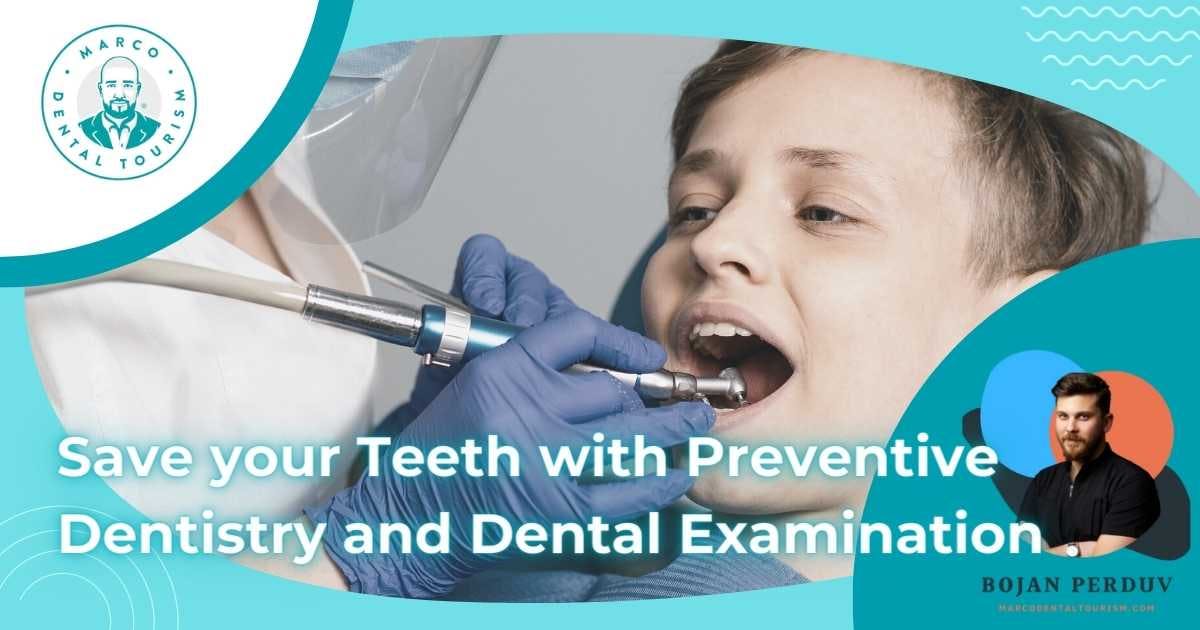Preventive Dentistry and Dental Examinations

How often do you visit your dentist for preventive examinations and check-ups? If you thought about it before continuing with further reading and realized that it is not in the list of priorities and daily obligations, don't worry! This blog is here to help you understand the importance of preventive dentistry and dental checkups and to motivate you to make going to the dentist a regular routine and even a pleasure. It's time to take control of your oral health and be proactive in preventing dental problems before they start - and this blog will show you how. We deal with prevention, education and answers to the most frequently asked questions regarding dental examinations. Welcome!
What is preventive dentistry?

Preventive dentistry involves the practice of taking steps to prevent dental disease and oral health problems before they occur. By identifying and treating potential problems early, preventive dentistry can help maintain healthy teeth and gums for many years.
How does preventive dentistry help prevent oral diseases?

Preventive dentistry helps overall dental health by promoting daily habits that reduce the risk of developing oral diseases. Regular tooth brushing and flossing, along with professional treatments, can protect teeth from caries and all other forms of disease in the long term.
What are the components of a dental examination?

A routine dental examination should include a dental history, an oral examination, as well as an examination of the teeth and gums. Regular dental examinations are a crucial component of dental health, and are usually composed of the following parts or segments:
Visual examination: The dentist uses a visual examination to look for any signs of caries, tooth discoloration or gum disease.
X-ray: X-rays provide a closer look at the teeth, allowing the dentist to see if there are cavities and other problems that cannot be seen visually.
Cleaning: In the next step, the dentist will use special tools to remove plaque and tartar. He will then polish the teeth to achieve an aesthetic shine.
Examination: The dentist will feel the teeth and gums to check for abnormalities, such as swelling, pain or tenderness.
Fluoride treatment: A dentist can apply a fluoride treatment that helps strengthen and protect teeth.
Scheduling the next visit: If caries or some other dental disease has been observed, the dentist will necessarily schedule the next examination, which includes the treatment of the diseased tooth and its regular control.
What are the most important elements of oral hygiene and how are they implemented?
Good oral hygiene is the key to a healthy smile! Implement a daily routine that includes brushing your teeth twice a day for two minutes, flossing daily, and using fluoride toothpaste. A healthy diet, moderation in sweet drinks and snacks, as well as regular dental examinations are also very important.
What is prophylaxis?

Prophylaxis in dentistry is preventive care that helps prevent dental diseases. It usually includes regular checkups, professional cleanings, fluoride treatments, and oral hygiene to help protect teeth from cavities and disease. Prevention is the first real step towards a confident smile.
What prophylaxis methods are used in preventive dentistry?

Prophylaxis or preventive dentistry is key to maintaining good oral health, and most often includes the following methods of preventing dental disease:
Use of fluoride: Fluoride treatments help strengthen enamel, making it less susceptible to plaque and acid. Treatments are usually done by professional application of fluoride or regular use of toothpaste containing fluoride and thorough mouth rinsing.
Professional cleaning: Regular teeth cleaning in the dental office helps to remove tartar, one of the main causes of various dental diseases.
Regular and thorough hygiene: Regular and thorough brushing of the teeth at home with a brush with soft fibers significantly helps in preventing the accumulation of bacteria and food residues that can cause caries and other dental problems.
How does fluoride help prevent tooth decay?
Fluoride helps prevent tooth decay by strengthening tooth enamel, making it more resistant to acid and sugar attacks from the food and drinks we eat. The best ways to apply fluoride are through the use of fluoride toothpaste and mouthwash, as well as regular professional dental treatments.
What is dental plaque?
Dental plaque is a sticky, colorless deposit formed on the teeth. It consists of bacteria, food particles and saliva. Plaque can harden into tartar, leading to tooth decay and other dental problems. Brush and floss regularly to remove plaque and prevent oral health problems.
How is dental plaque identified and removed?

Plaque appears as a light-colored sticky film that forms on our teeth. The dentist identifies the plaque by visual inspection and removes it with professional cleaning techniques such as precise scraping and polishing, which prevents the formation of calculus that leads to serious dental problems.
What are the risk groups for caries development and how is it prevented?

Cavities are caused by bacteria that consume sugar and produce acid that then damages the teeth. Therefore, risk groups for the development of caries include people who do not take care of regular oral hygiene, those who consume a lot of sweet food and drinks, as well as smokers prone to the problem of dry mouth.
The best ways to prevent tooth decay are:
Daily hygiene: Brush your teeth at least twice a day using a fluoride toothpaste to remove plaque and food debris from the surface of your teeth.
Flossing: Floss hard-to-reach areas of your teeth daily to clean food debris between your teeth and along the gum line.
Healthy meals: Eat a balanced, nutritious diet full of fruits and vegetables to ensure oral health.
Avoiding sugary snacks and carbonated drinks: Limiting your intake of sugar and drinks can go a long way in protecting your teeth from cavities and harmful bacteria.
Visiting the dentist every six months: Visit your dentist regularly for a professional cleaning and check-up to prevent and treat any dental problems in time.
What is periodontitis, how is it caused and how is it treated?
Periodontitis is an advanced form of gum disease that causes severe gum inflammation, bone loss, or potential tooth loss. It is caused by bacteria that accumulate around the teeth, damaging the gums and bone. Treatment includes antibiotics and professional cleanings to remove plaque and tartar.
Conclusion on the importance of preventive dentistry

By following a few simple steps and making small lifestyle changes, we can all prevent dental problems and maintain a healthy, beautiful smile. Brushing your teeth twice a day, flossing daily, rinsing your mouth and visiting the dentist regularly are basic habits for keeping our teeth and gums in a sparkling condition. Prevention is key, and taking the time to care for our teeth will pay off in the long run.














Share your opinion!
What do you think about this topic?
Comments (0)